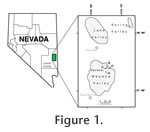|
|
|
INTRODUCTIONThe Panaca local fauna (l.f.) described by Chester Stock (1921) is located in Meadow Valley, south of Panaca in Lincoln County, southeastern Nevada (Figure 1). Stock named the sediments the Panaca Formation. The fossils from Panaca Stock (1921) described included Pliohippus sp., ?Teleoceras sp., and Pliauchenia (now considered Hemiauchenia), genera that were assigned generally to the Hemphillian North American Land Mammal Age (NALMA), although precise age of the Panaca l. f. was questionable (Stirton 1940; Macdonald and Pelletier 1956). Later, G.E. Hazen and H.S. Gentry, working for the Frick Laboratory of the American Museum of Natural History (F:AM) during the 1940s, collected more fossils from Meadow Valley, noting that most of the fossils they found from the Panaca area were younger than the fossils collected earlier by Stock. Later still, both small and large mammals were collected from the Panaca area by T. Galusha and R. Emry, working for the AMNH. Some of those fossils were described by May (1981), Repenning (1987), and White (1987, 1991). Mou (1997, 1998) described a new species of arvicoline rodent from the Panaca l.f., based on its enamel schmelzmuster. All of the small mammals collected from the Panaca area are indicative of Blancan NALMA. More recently, Lindsay et al. (2002) resumed collection of small mammals in Meadow Valley, placing them in a magnetostratigraphic framework, to shed light on placement of the Hemphillian/Blancan boundary in these deposits, and concluding that they are of Blancan NALMA. Arvicolines are high-crowned, grass eating rodents in the cricetid family. Partly due to the nature of their diet, they exhibit gradual evolution in their dental morphology through geological time. The earliest such rodents living in North America are represented by the Hemphillian Paramicrotoscoptes and Goniodontomys (Wilson 1937; Hibbard 1959; Martin 1975; Repenning 1987). These two genera are in the Subfamily Prometheomyinae rather than Subfamily Arvicolinae (Korth 1994). The earliest true arvicoline in North America is the late Hemphillian Promimomys minor, considered to be an immigrant closely related to Eurasian Promimomys cor (Repenning 1968; von Koenigswald and Martin 1984; Repenning 1987). The arvicolines became abundant during the early Blancan and have thrived since then. Because of their rapid evolution and wide distribution, they have provided an important source for ordering biochronologic events in late Tertiary terrestrial deposits in Europe and North America. Repenning (1987, 2003) provided a thorough biochronologic review of North American arvicolines. He divided the Blancan land mammal age into five stages based on immigration events. The first appearance of Mimomys, represented by Mimomys (Ophiomys) mcknighti and Mimomys (Ogmodontomys) sawrockensis, is considered the beginning of Blancan land mammal age. Repenning et al. (1990) compared this biochronological framework with the mammalian biochronology of Europe. However, the taxonomy of Mimomys in North America has been controversial. Mimomys was first recognized in Europe (Forsyth Major 1902). Since then, three subgenera and fifteen species have been found in Europe (Fejfar et al. 1990; Fejfar and Heinrich 1989). Repenning and others (Repenning 1987; Fejfar and Repenning 1992; Repenning et al. 1995) considered North American Ophiomys, Cosomys, and Ogmodontomys as subgenera of Mimomys and correlated them with faunal exchanges between Eurasia and North America, which in turn had implications relative to late Cenozoic climate changes (Repenning 1980; Repenning et al. 1995). von Koenigswald and Martin (1984) and Martin et al. (2002) pointed out that Ophiomys, Cosomys, and Ogmodontomys have enamel microstructure that differs from that of European Mimomys, and thus considered that these three subgenera were endemic North American arvicoline rodents rather than immigrants from Europe. The most diagnostic teeth of arvicolines are the first lower molar (m1) and the last upper molar (M3). However, it should be noted that there are considerable intraspecific variations in the dental morphology of these rodents, and the occlusal morphology may change markedly through wear, even on a single tooth. Therefore, a reliable identification requires a large sample, preferably including both m1s and M3s. Fortunately, abundant arvicoline rodents have been collected from the Panaca l.f. Repenning (1987) referred two specimens from the Rodent Hill locality near Panaca that were collected by the F:AM to two species: Mimomys (Ophiomys) magilli and Pliopotamys meadensis. Based on these identifications, he placed the Panaca l.f. in the middle Blancan (Repenning 1987). Further collection from another locality near Panaca by University of Arizona paleontologists yielded a large sample of arvicoline teeth. Mou (1997) could not recognize the above two species from this sample; instead, she erected a new species, Mimomys panacaensis, represented by this population. A combination of characters of this new species excludes it from any of the three arvicolines (e.g., Ophiomys, Cosomys, and Ogmodontomys). M. panacaensis shows a number of primitive characters, including small size, low dentine tract, and 47% of M3s with three roots. Mou (1997) suggested that the evolutionary stage of M. panacaensis is close to that of M. (Ophiomys) mcknighti, and thus it should represent early Blancan instead of middle Blancan. Mou (1998) later studied the enamel microstructure of M. panacaensis.and found its primitive schmelzmuster comparable to that of early European Mimomys, suggesting that M. panacaensis probably was an immigrant from Eurasia. In later field seasons, more fossil sites were found in Panaca, and each site produced large sample of arvicoline teeth. These samples permitted a more clear and reliable identification of these rodents. In addition to M. panacaensis, a new genus Nevadomys n. gen., including three new species, is recognized from the Panaca l.f. |
|
